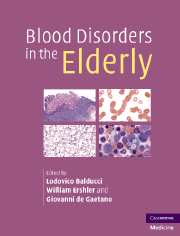Book contents
- Frontmatter
- Contents
- List of contributors
- Preface
- Part I Epidemiology
- 1 Epidemiology of aging
- 2 Epidemiology of anemia in older adults
- 3 Cancer in the older person: a comprehensive approach
- 4 From fitness to frailty: toward a nosologic classification of the older aged person
- Part II Hematopoiesis
- Part III Anemia of aging
- Part IV Hematologic malignancies and aging
- Part V Disorders of hemostasis in the elderly
- Index
4 - From fitness to frailty: toward a nosologic classification of the older aged person
from Part I - Epidemiology
Published online by Cambridge University Press: 21 October 2009
- Frontmatter
- Contents
- List of contributors
- Preface
- Part I Epidemiology
- 1 Epidemiology of aging
- 2 Epidemiology of anemia in older adults
- 3 Cancer in the older person: a comprehensive approach
- 4 From fitness to frailty: toward a nosologic classification of the older aged person
- Part II Hematopoiesis
- Part III Anemia of aging
- Part IV Hematologic malignancies and aging
- Part V Disorders of hemostasis in the elderly
- Index
Summary
Introduction
In exploring the assessment of the older aged person, this chapter has two goals. The first is to estimate a person's life expectancy, tolerance of stress, medical, rehabilitative, and supportive needs in planning the management of hematologic conditions. The second is to relate hematologic findings to a physiologic rather than chronologic classification of age, reflecting the function and the health status of each individual. A special assessment is needed because aging occurs at different rates for different individuals, and, in the same individual, for different functions.
Various forms of geriatric assessment were developed by geriatricians with the goal to preserve or restore health and functional independence, that is the ability to survive alone. In the scope of these assessments, the older population was composed of two groups of individuals. The first group, which becomes larger with increasing age, includes people who are functionally dependent, for whom the goal of management is to restore function and to prevent further functional deterioration. These individuals may be affected by multiple medical conditions that contribute to their dependence. The second group, which becomes smaller with advancing age, includes people who are still independent. In this case, the assessment is aimed to identify those at risk of functional decline, disease, and death, and the goal of management is to try to prevent or delay these occurrences.
- Type
- Chapter
- Information
- Blood Disorders in the Elderly , pp. 39 - 54Publisher: Cambridge University PressPrint publication year: 2007



